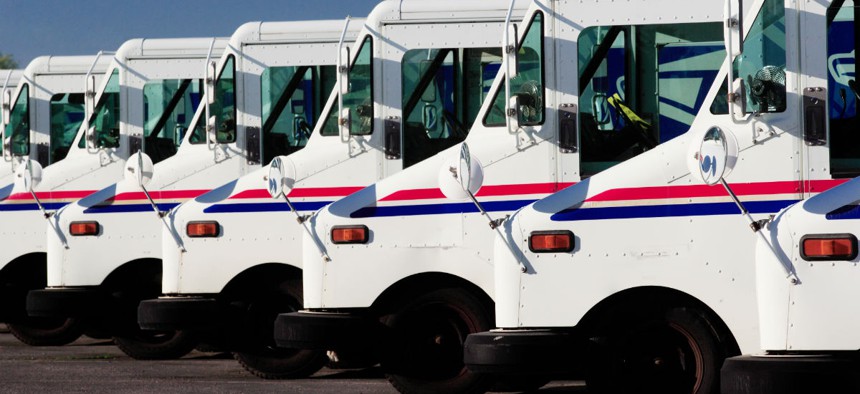
B Brown / Shutterstock.com
Lawmakers Think Postal Delivery Trucks Can Do Better Than 10 Miles per Gallon
As USPS gears up for fleet overhaul, members of Congress push for greener vehicles.
This story has been updated.
The U.S. Postal Service has been complaining about its aging vehicle fleet for years, but it has not had the funds to do anything about it.
While the agency is still losing billions annually, recent downsizing efforts have freed up some operational cash. That led new Postmaster General Megan Brennan to promise to make some capital investments after years of cuts. In February, USPS finally issued a request for proposals for manufacturers to provide 180,000 new vehicles valued collectively at $4.5 billion to $6.3 billion. The order would almost entirely replace USPS’ fleet of 211,000 vehicles, which agency officials call “one of the largest civilian fleets in the world.”
Postal management is looking for vehicles with an array of specifications, ranging from a less boxy design to stronger windshield wipers to better cup holders. Lawmakers in both chambers of Congress, however, have focused on a different priority for the next crop of USPS automobiles: efficiency.
Rep. Jared Huffman, D-Calif., this week introduced the Federal Leadership in Energy Efficient Transportation (FLEET) Act, which would require the Postal Service to reduce its petroleum consumption by 2 percent each year over the next 10 years. The new standards would cut USPS’ fuel usage by 250 million gallons and save $350 million in that period, Huffman said, while turning the agency into a “global leader in efficiency and innovation.”
The vast majority of the vehicles are those designed for delivery, which -- according to a 2009 inspector general report -- average just 10 miles per gallon. That report suggested the Postal Service could convert some of its fleet to electric vehicles.
On Thursday, three Democratic senators wrote a letter to Brennan urging the agency to “invest in cutting-edge vehicle improvements that will reduce emissions, decrease accidents, and save lives in communities across the country.”
Sens. Cory Booker, N.J., Brian Schatz, Hawaii, and Gary Peters, Mich., all members of the Commerce, Science and Transportation Committee, asked Brennan how Congress could assist the Postal Service in acquiring a more efficient fleet, as well as what steps the agency is taking to ensure the new vehicles are equipped with better fuel economy.
In addition to the higher fuel standards, the lawmakers said USPS should better leverage new safety technologies, such as automatic braking and in-vehicle cameras. Postal vehicles are involved in 20,000 accidents annually, the senators noted, meaning the features would both increase safety and save money.
“This transition provides USPS with a unique opportunity to lead the country in the use of safer, more fuel efficient vehicles,” the senators wrote.
The Postal Service has already narrowed down the list of potential vehicle suppliers to 15 candidates and expects to make a decision this summer. The list includes many familiar names, such as Ford, Fiat Chrysler and Nissan, as well as one company -- AMP Holding Inc. -- that produces all-electric trucks.
(Image via B Brown / Shutterstock.com)







